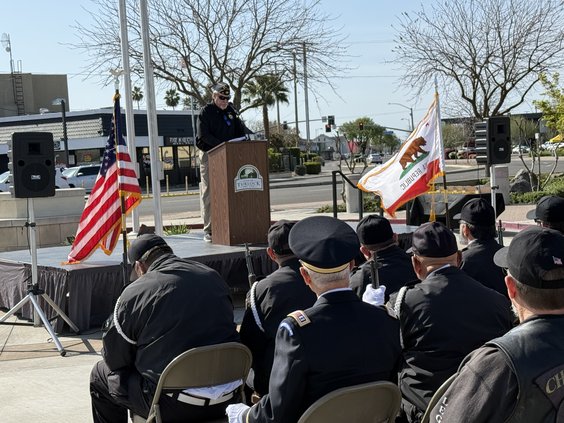The California Department of Public Health issued a health advisory Tuesday urging people to stay away from all vaping products as health officials expect to see even more cases of lung illnesses from vaping.
The advisory urges everyone to refrain from vaping, no matter the substance or source, until current investigations into the cause of the illnesses is determined. The health advisory follows an executive order signed by Gov. Gavin Newsom Sept. 16 that allocates $20 million towards a statewide digital and social media public awareness campaign to educate youth, young adults and parents about the health risks of vaping nicotine and cannabis products.
As of Sept. 24, the CDPH has received reports that 90 people in California who have a history of vaping were hospitalized for severe breathing problems and lung damage, and two people have died. The last tally from the CDC showed 530 cases in the United States and nine deaths, however, CDC Principal Deputy Director Dr. Anne Schuchat told a congressional subcommittee that hundreds more cases have been reported to local health districts that have not been included in the national tally as of yet.
“We are seeing more and more cases each day and I expect the next weekly numbers will be much higher,” Schuchat said.
The CDC and the Food and Drug Administration are investigating outbreak but they have not yet identified a common electronic cigarette or ingredient that is causing the lung illnesses. Almost all people with lung damage from vaping say that they vaped or "dabbed" the cannabis products THC and CBD in cartridges, waxes, oils, and other forms. Some people report vaping only nicotine. Many people report vaping a combination of both nicotine and cannabis products.
“We are seeing something that we have not seen before,” said Dr. Charity Dean, acting state public health officer. “There are numerous unknown factors at this time, and due to the uncertainty of the exact cause, it is our recommendation that consumers refrain from vaping until the investigation has concluded.”
The CDPH said they are learning through the investigation that the lung illness can come on very quickly, even for people who have not been vaping for a long time. It’s also sickening young, healthy people who do not have lung disease or other health problems. This is different from most other health issues caused by vaping and smoking, which happen over a long time and can be worse in people who have other medical conditions. Additionally, most patients do not have a recent history of smoking regular cigarettes, suggesting these lung issues are exclusively related to vaping.
In many cases, patients reported a gradual start of symptoms, including breathing difficulty, shortness of breath, and/or chest pain before hospitalization. Some cases reported mild to moderate gastrointestinal illness including vomiting and diarrhea, or other symptoms such as fevers or fatigue, according to the CDC.
These symptoms are very similar to having a lung infection like pneumonia or bronchitis, so it can be hard to tell if the symptoms are from an infection or vaping the first time someone sees the doctor. There is no test that a doctor can do to know that breathing problems are from vaping right away. Laboratory blood tests and an x-ray or CT scan of the lungs may be necessary.
The CDPH reported that almost half of the cases in California involve teenagers or young adults and that 30 percent of the patients hospitalized in the state were in intensive care units and on ventilators.
A number of those who have been sickened with the lung ailment reported purchasing the products from unlicensed cannabis retailers, such as street vendors or pop-up shops. Health officials have also identified vitamin E acetate in some of the suspect products.
County health departments are contacting the people who had lung damage from vaping to find out which products they used, where they purchased the products and to collect their vape products to test for harmful ingredients.
The government does not ensure the safety of vaping devices through regulation. In California, licensed cannabis retailers are required to sell products obtained from a licensed cannabis manufacturer that have been tested by a licensed laboratory. Cannabis products sold by licensed sources are tested for a variety of chemicals, pesticides, microbial impurities, and heavy metals. Illegal cannabis dispensaries sell unregulated and untested cannabis products and absolutely should not be used.
James Wilson, the owner of Vapor Mo’s in Turlock and Stockton, worries that the current view on vaping will stop some people from using it as a method to stop smoking cigarettes, which in his opinion, is far worse than vaping.
“They have made these blanket statements about vaping and that has created a lot of negativity around it,” Wilson said. “Other countries have embraced vaping as a way to stop smoking.”
Wilson said vaping helped him quit his own smoking habit, which he had for 26 years.
“I feel so much better and don’t have those coughing attacks in the morning like I used to when I was a smoker,” he said.
Wilson opened his Turlock location in 2015 with the vision that it would help wean people off of nicotine. The shop doesn’t sell any tobacco products and mixes the vaping juice on site, using four components — propylene glycol (which is used in inhalers), vegetable glycerin, flavorings and nicotine. Wilson said the nicotine they use at the store comes from tomatoes, squash and eggplants.
“By making it on site, we know exactly what is in our products,” Wilson said.
The CDPH advises that if anyone experiences difficulty breathing after vaping, they should contact a doctor immediately.









